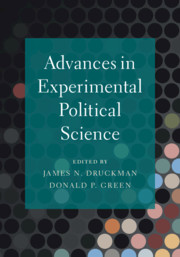Book contents
- Frontmatter
- Contents
- List of Figures
- List of Tables
- List of Boxes
- List of Contributors
- Acknowledgements
- 1 A New Era of Experimental Political Science
- Part I Experimental Designs
- Part II Experimental Data
- Part III Experimental Treatments and Measures
- Part IV Experimental Analys is and Presentation
- 14 Advances in Experimental Mediation Analysis
- 15 Subgroup Analysis: Pitfalls, Promise, and Honesty
- 16 Spillover Effects in Experimental Data
- 17 Visualize as You Randomize: Design-Based Statistical Graphs for Randomized Experiments
- Part V Experimental Reliability and Generalizability
- Part VI Using Experiments to study Identity
- Part VII Using Experiments to Study Government Actions
- Author Index
- Subject Index
16 - Spillover Effects in Experimental Data
from Part IV - Experimental Analys is and Presentation
Published online by Cambridge University Press: 08 March 2021
- Frontmatter
- Contents
- List of Figures
- List of Tables
- List of Boxes
- List of Contributors
- Acknowledgements
- 1 A New Era of Experimental Political Science
- Part I Experimental Designs
- Part II Experimental Data
- Part III Experimental Treatments and Measures
- Part IV Experimental Analys is and Presentation
- 14 Advances in Experimental Mediation Analysis
- 15 Subgroup Analysis: Pitfalls, Promise, and Honesty
- 16 Spillover Effects in Experimental Data
- 17 Visualize as You Randomize: Design-Based Statistical Graphs for Randomized Experiments
- Part V Experimental Reliability and Generalizability
- Part VI Using Experiments to study Identity
- Part VII Using Experiments to Study Government Actions
- Author Index
- Subject Index
Summary
We present current methods for estimating treatment effects and spillover effects under “interference”, a term which covers a broad class of situations in which a unit’s outcome depends not only on treatments received by that unit, but also on treatments received by other units. To the extent that units react to each other, interact, or otherwise transmit effects of treatments, valid inference requires that we account for such interference, which is a departure from the traditional assumption that units’ outcomes are affected only by their own treatment assignment. Interference and associated spillovers may be a nuisance or they may be of substantive interest to the researcher. In this chapter, we focus on interference in the context of randomized experiments. We review methods for when interference happens in a general network setting. We then consider the special case where interference is contained within a hierarchical structure. Finally, we discuss the relationship between interference and contagion. We use the interference R package and simulated data to illustrate key points. We consider efficient designs that allow for estimation of the treatment and spillover effects and discuss recent empirical studies that try to capture such effects.
Keywords
- Type
- Chapter
- Information
- Advances in Experimental Political Science , pp. 289 - 319Publisher: Cambridge University PressPrint publication year: 2021
- 12
- Cited by



